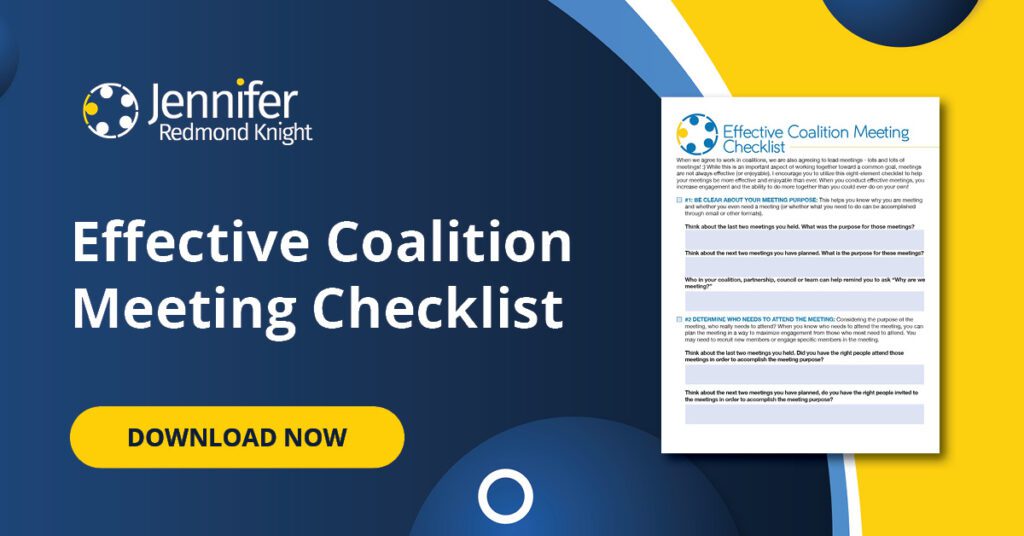Let’s face it. Coalition work = meetings. As much as we may be weary from meetings or feel like we are constantly moving from meeting to meeting, this is how we work together. As we have transitioned from primarily in-person meetings to primarily virtual meetings, we have learned a lot about what works – and doesn’t work so well. We are also entering a new season when most meetings are virtual but some of us are now having a few in-person meetings again (with masks) and attempting to find ways to engage our participants in meaningful discussions that lead to action that makes an impact. If you are ready to think (or re-think) meetings, join me as I discuss eight elements of effective meetings. Today’s post is a high-level overview of the eight elements and then we will review each element more closely.
#1 Be clear about your meeting purpose
In order to conduct an effective meeting, we need to be clear about why we are meeting and how a meeting will accomplish this purpose. If our purpose can be accomplished through an email or a recorded video, then we may not need to meet. Alternatively, if we need to discuss an important issue and identify collective solutions, then a meeting is necessary. Find someone in your coalition willing to keep asking “Why are we meeting?”
#2 Determine who needs to attend your meetings
Once you are clear about your meeting purpose, then you can ask “Who needs to attend the meeting?” When you know who needs to attend the meeting, you can plan the meeting in a way to maximize engagement from those who most need to attend. Even though you may want to invite everyone to every meeting, this may not help you accomplish your meeting purpose and may not be the best investment of time from your coalition members. Think carefully about who needs to be involved in order to accomplish the meeting purpose. Also, remember, you may not currently have the right people involved to accomplish the meeting purpose. You may need to recruit new coalition members or partners.
#3 Decide which meeting format will work best
Knowing your meeting purpose and the attendees needed to accomplish that purpose will guide you toward your meeting format. If you are working together on a project and need to share information, you will want to consider a video chat or in-person meeting option. If your meeting is to “check in” with someone you work with regularly, you may be able to do this through a phone call. One of the best ways to incorporate exercise in the middle of the day is to host a phone call meeting where you can walk and talk! Also, check in with your standing meetings. If your meeting purpose does not always require a meeting, then some of these can be converted to email or other formats.
#4 Develop an agenda that reflects the meeting purpose
We all work on deadlines. If we are asking our coalition team to do something without a date attachedOne of the biggest challenges in coalition meetings is being realistic about meeting time and agenda items. When you reflect on the meeting purpose, consider the 1-3 items that need to be on the agenda in order to accomplish that purpose. If you are taking the time to meet (and it is not designated as a webinar), leave enough time in the agenda for discussion, engagement and decision making throughout the meeting.
#5 Prepare logistics for the meeting
When planning a meeting, recognize all of the logistics needed for the meeting to work effectively. Also, consider the people responsible for each aspect of the meeting plan. This is the aspect of meeting planning that can quickly become overwhelming and time consuming. Recognize that there are multiple details and logistics needed to plan a meeting. Allow yourself more time than you think it will take to manage the meeting plan and recruit people to implement the meeting plan with you.
#6 Set expectations for meeting participants
In order to conduct an effective meeting, you need to set expectations before, during and after the meeting. Remember that the meeting participants have not been thinking about this meeting nearly as much as you have. If possible, send the agenda at least a week in advance and clearly articulate what you will be doing and how you want them to be engaged. When you begin the meeting, remind participants of the meeting purpose. As you send the notes and action items from the meeting, make it clear how they can stay engaged in action items from the meeting.
#7 Facilitate the meeting well
One of the most critical components to an effective meeting is facilitation. You want the person(s) facilitating the meeting to be energetic, engaging and able to guide the participants toward accomplishing the meeting purpose. Even if you have a clear purpose, the right people and a format conducive to an effective meeting, if you do not facilitate the meeting well, your meeting will not be effective. Consider your staff or coalition leaders. Who has the skills, ability and interest in facilitating each of the meetings? Depending upon the meeting, you may need to seek an outside or external facilitator in order to accomplish your meeting purpose.
#8 Follow-up from the meeting
You may have facilitated a fantastic meeting where you engaged participants, made important decisions and made progress on your most important projects; however, the real test of an effective meeting happens after the meeting is over. Once you have had an effective meeting, it is critically important to follow-up as quickly as possible to keep the momentum, progress and relationships going. During these days of ongoing online meetings, it can be really challenging to find the time to follow-up because you have the next meeting – and the next – and the next. Before you host your next meeting, schedule time on your calendar for follow-up for that meeting!
So what about you? Which of these elements would you like to practice implementing with your next meeting?
Check out my newest free resource, Effective Meeting Checklist for additional guidance on implementing these elements.
Photo by Christina @ wocintechchat.com on Unsplash

